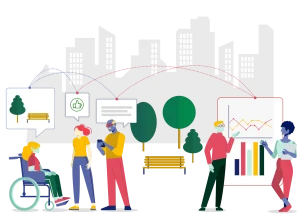Innovations in Supply Chain and Logistics Management

Innovations in supply chain and logistics management are making it easier for small businesses to expand. From self-driving carrier trucks to fulfillment robots, these technologies help online brands meet customers’ expectations for fast and affordable delivery services.
Flexible digital solutions enable warehouses and production centres to adjust capacity quickly to fluctuations in demand or disruptions, increasing operational effectiveness by decreasing error rates and streamlining work processes.
Internet of Things (IoT)
IoT involves smart devices that monitor physical objects’ conditions and transmit this data back to a central management system, providing valuable insights for logistics analysis as well as improving operational efficiencies and cost reductions.
IoT sensors enable businesses to monitor equipment and vehicles in real-time to reduce downtime and optimize asset utilization, meeting environmental regulations and sustainability goals while at the same time meeting company compliance. Logistics providers also benefit from IoT connectivity as it helps monitor shipment locations and temperatures to ensure perishables arrive intact.
IoT provides other benefits as well, such as remote container management – a revolutionary supply chain innovation using real-time tracking to streamline and automate processes – which helps businesses maximize profits by eliminating wasteful links and streamlining logistics processes, while simultaneously encouraging seamless collaboration among supply chain partners for improved planning and decision-making capabilities. Cold chain monitoring with this solution is especially advantageous to prevent spoilage of perishable goods.
Artificial Intelligence (AI)
AI can significantly boost supply chains and operations by using intelligent strategies. AI has proven invaluable for reducing inventory losses, anticipating shortages and mitigating risks by analyzing massive sets of logistic data to identify potential bottlenecks or out-of-stock situations before they occur and providing companies with timely responses in order to quickly mitigate risks.
AI in logistics offers many advantages for automated warehousing and transportation, such as route optimization algorithms that determine the most efficient routes based on real-time and historic data for deliveries, helping businesses save on storage and transport costs while meeting customer satisfaction goals.
Implementing AI solutions can be expensive and time consuming, and finding skilled professionals to manage one can be challenging. To avoid these obstacles, some organizations opt for an agile approach to AI integration by partnering with third-party vendors who allow them to start small before expanding as required.
Crowd Shipping
Crowd shipping models employ individual users with personal vehicles who offer delivery services, using any excess capacity they may have to make money through offering crowd shipping. Participants in these arrangements are compensated either financially or non-monetary incentives – thus competing with traditional logistics service providers as an innovative logistic service and creating disruptive value propositions.
People and businesses can utilize on-demand community delivery apps to request instantaneous delivery services that local couriers or contract drivers accept based on their schedule and availability. Some crowd delivery platforms also utilize secure locker systems strategically placed for convenient use by crowd delivery platforms – an initiative which is research has demonstrated can foster cost-efficiency and supply chain agility.
However, its feasibility depends on factors like how closely a platform matches demand with supply, as well as how effectively crowd shipping recruits and incentivizes its members. Therefore, crowd shipping might become an attractive solution to some logistical tasks by addressing such concerns.
Supply Chain Integration Platforms
Supply chain integration involves interlinking systems and automating processes in order to improve visibility and coordination across all aspects of a supply chain, including inventory management, production planning, distribution, transportation, warehouse operations and warehouse operations. It’s a core element of logistics management because it improves visibility across every component of an overall supply chain including inventory control, production planning, distribution logistics transport operations warehouse operations etc.
As manufacturers must maintain inventory levels at appropriate levels, logistics companies must oversee their truck fleet and shipping lines must reroute shipments during unexpected business disruptions, having access to an integrated integration approach offering both EDI and API integration can assist companies quickly respond to unexpected disruptions of logistics operations.
Reduce time-to-market and streamline partner onboarding with a scalable integration platform that supports B2B integrations for both cloud and hybrid environments. A unified supply chain management solution is easier to maintain and scale as business requirements change, while an iPaaS system improves reusability, productivity, and overall user experience for businesses, helping them move beyond siloed on-site systems to embrace an interlinked global supply chain network.


